B404X Datasheet

This is a graphic of the B404. The B404X has the same exterior dimensions but the appearance may vary slightly from this graphic.
Functional description
Overview
The B-Series System-on-a-Module (SoM) is a cellular device with support for BLE (Bluetooth LE). It is based on the Nordic nRF52840 microcontroller.
The B-Series is designed to be integrated into your circuit board design, plugging into a M.2 NGFF connector on your board, allowing the module to be changed or upgraded easily.
Features
Features - B404X
- u-blox SARA-R510S-01B LTE modem (B404X)
- LTE Cat M1 module
- Support for United States, Canada, and Mexico only
- 3GPP Release 14 LTE Cat M1
- LTE Cat M1 bands: 2, 4, 5, 12, 13
- Embedded Particle EtherSIM (B404X)
- Requires Device OS 4.0.0 LTS (or later)
Features - all models
- Nordic Semiconductor nRF52840 SoC
- ARM Cortex-M4F 32-bit processor @ 64MHz
- 1MB flash, 256KB RAM
- Bluetooth 5: 2 Mbps, 1 Mbps, 500 Kbps, 125 Kbps
- Supports DSP instructions, HW accelerated Floating Point Unit (FPU) and encryption functions
- Up to +8 dBm TX power (down to -20 dBm in 4 dB steps)
- NFC-A tag
- On-module additional 4MB SPI flash
- 24 mixed signal GPIO (8 x Analog, 8 x PWM), UART, I2C, SPI
- USB 2.0 full speed (12 Mbps)
- JTAG (SWD) pins
- Pins for RGB LED used for connection status
- Pins for reset and mode buttons
- On-module MFF2 Particle SIM
- Two on-module U.FL connectors for external antennas
- M.2 interface
- FCC (United States) and ISED (Canada) certified
- RoHS compliant (lead-free)
Model comparison
| B404X | B404 | B402 | B524 | B523 | B504e | |
|---|---|---|---|---|---|---|
| Region | NorAm | NorAm | NorAm | EMEAA | Europe | Americas |
| EtherSIM | ✓ | ✓ | ✓ | ✓ | ||
| Supply Secure | ✓ | ✓ | ✓ | |||
| Lowest power (LTE Cat M1) | ✓ | ✓ | ✓ | |||
| Fastest speed (LTE Cat 1) | ✓ | ✓ | ✓ | |||
| Cellular fallback | 3G, 2G | 3G, 2G | 3G | |||
| Lifecycle | GA | NRND | Deprecated | GA | Deprecated | In development |
- EtherSIM devices generally have a larger number of carriers and more may be added in the future
- NorAm: North America (United States, Canada, and Mexico)
- Americas: North America, Central, and South America (not all countries supported)
- LTE Cat M1: Low-power cellular intended for IoT devices
- LTE Cat 1: Available in more countries and has higher data rates
- EMEAA: Europe, Middle East, Africa, and Asia (not all countries supported)
- NRND: Not recommended for new designs
- See the Carrier list for specific carrier and country compatibility
- See the Supply secure FAQ for more information
- See Lifestyle stages for more information
Device OS support
It is recommended that you use the latest version in the 4.x LTS release line with the B404X. The minimum required version is 4.0.0. You cannot use the B404X with Device OS 2.x LTS.
For information on upgrading Device OS, see Version information. For the latest version shipped from the factory, see Manufacturing firmware versions page. See also Long Term Support (LTS) releases.
Interfaces
Block diagram
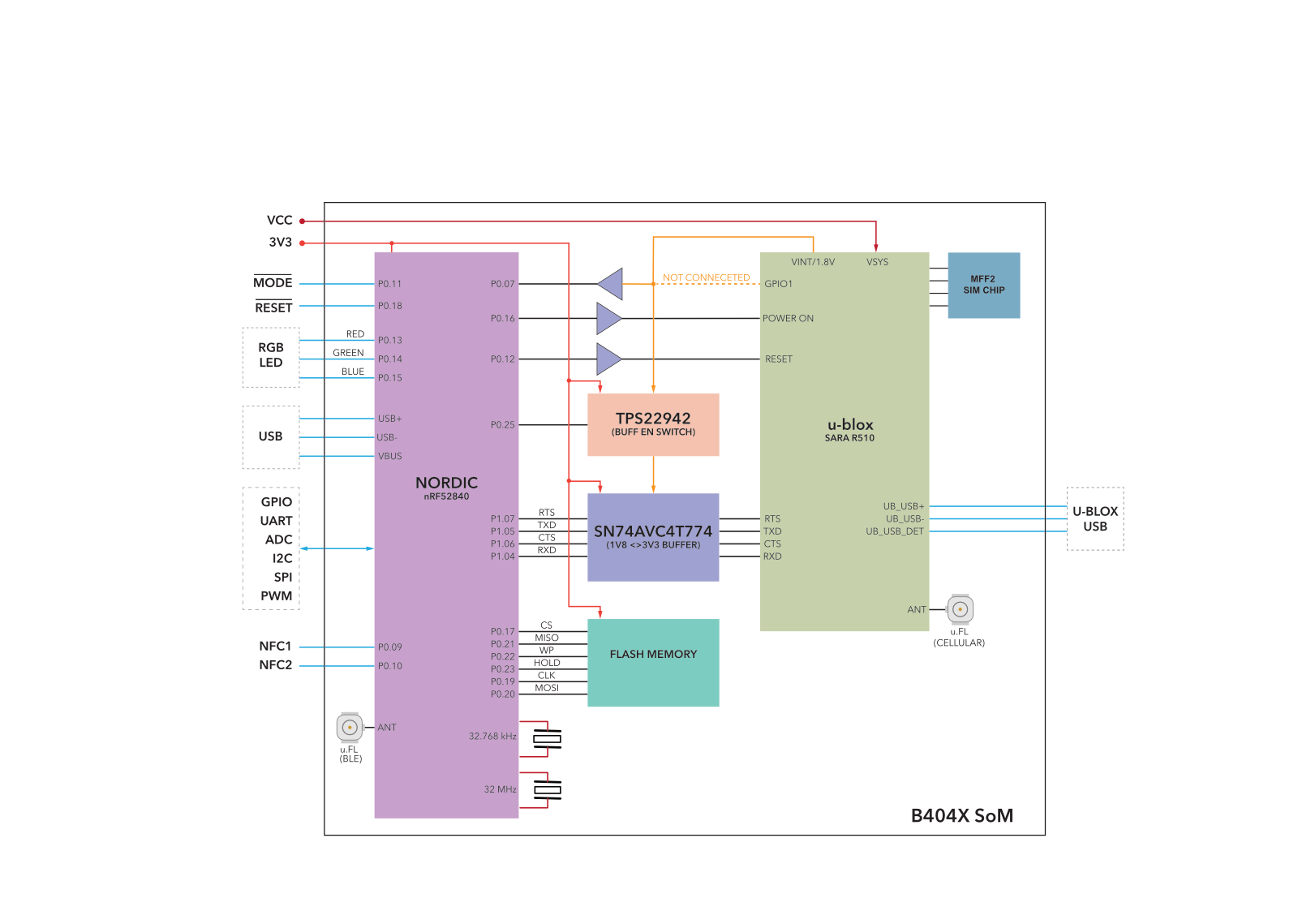
Power
VCC
VCC is used to supply power to the u-blox SARA-R510S cellular module. The recommended input voltage range on this pin is between 3.6V to 4.2V DC. This can be connected directly to a 3.7V LiPo battery.
If you are not using a battery, or using a battery of a different voltage, you should use a regulator to supply 3.7V to 4.2V. While you only need 600mA for the B404X, we recommend 2A for compatibility with future SoM modules.
3V3
3V3 is used to supply power to nRF52840, logic ICs, memory, etc.. The 3V3 input voltage range is between 3V to 3.6V DC, but 3.3V is recommended. Make sure that the supply can handle a minimum of 150 mA, however we recommend a minimum of 500 mA supplied from your base board to allow for compatibility with future modules.
These limits do not include any 3.3V peripherals on your base board, so that may increase the current requirements.
Power supply requirements:
- 3.3V output
- Maximum 5% voltage drop
- 100 mV peak-to-peak ripple maximum
- 500 mA minimum output current at 3.3V recommended for future compatibility
- Maintain these values at no-load as well as maximum load
We do not recommend using a single 3.6V supply for both VCC and 3V3 as the cellular modem performance may be lower below 3.7V. Use two separate regulators for best results.
VBus
VBus is connected to the USB detect pin of nRF52840 to enables the USB interface. The recommended input voltage range is between 4.35V to 5.5V DC.
Antenna
There are two radios on the B402 module. A BLE radio (nRF52840) and a cellular radio (u-blox). We have provided two u.FL connectors to plug in the cellular and BLE antenna. These are required if you wish to use the cellular and BLE. If you do not need BLE, you do not need to connect the BLE antenna.
Certified cellular antenna
The following antenna is included in single-unit packages that include an antenna.
| Antenna | SKU | Details | Links |
|---|---|---|---|
| Wide band LTE-CAT M1 cell antenna, [x1] | PARANTC41EA | B404X, BRN404X, and E404X | Datasheet |
| Wide band LTE-CAT M1 cell antenna, [x50] | PARANTC41TY | B404X, BRN404X, and E404X | Datasheet |
General antenna parameters:
| Parameter | Value | Unit |
|---|---|---|
| Antenna Type | Dipole | |
| Radiation Properties | Omnidirectional | |
| Maximum Input Power | 5 | watts |
| Polarization | Linear | |
| Impedance | 50 | ohms |
Antenna parameters in frequency ranges:
| Parameter | 698 MHz - 894 MHz | 1700 MHz - 2690 MHz | Unit |
|---|---|---|---|
| Peak Gain | 2.46 | 3.86 | dBi |
| Efficiency | 65.46 | 54.95 | % |
| Average Gain | 1 | 0.98 |
Antenna parameters in specific frequency bands:
| Parameter | 698 MHz | 894 MHz | 1700 MHz | 2170 MHz | 2690 MHz | Unit |
|---|---|---|---|---|---|---|
| Max VSWR | 1.6 | 1.8 | 1.7 | 2.8 | 2.5 | |
| Max Return Loss | -12 | -10 | -11 | -6 | -7 | dB |
Mechanical:
| Parameter | Value | Unit |
|---|---|---|
| Dimensions | 122.1 x 12.8 x 0.2 | mm |
| Material | Flexible polymer | |
| Connector and cable | U.FL and 1.13mm mini coax | |
| Cable length | 183 | mm |
Environmental:
| Parameter | Value |
|---|---|
| Operating temperature | -40°C to 85°C |
| Storage temperature | -40°C to 85°C |
| ROHS Compliant | ✓ |
Particle devices are certified for use only with the designated antenna specified above. The use of alternative antennas with our modules could necessitate a recertification process. To fully understand the potential consequences of using a non-certified antenna, Particle strongly advises seeking consultation with a qualified RF expert.
Alternate cellular antenna
Additionally, the following antenna is certified as an alternative antenna.
| Antenna | SKU | Details | Links |
|---|---|---|---|
| Taoglas Cellular Flex Antenna 2G/3G/LTE 5dBi, [x1] | ANT-FLXU | Boron and Electron/E-Series LTE M1 | Datasheet | Retail Store |
| Taoglas Cellular Flex Antenna 2G/3G/LTE 5dBi, [x50] | ANT-FLXU-50 | Boron and Electron/E-Series LTE M1 | Datasheet |
General antenna parameters:
| Parameter | Value | Unit |
|---|---|---|
| Antenna Type | Dipole | |
| Radiation Properties | Omnidirectional | |
| Maximum Input Power | 5 | watts |
| Polarization | Linear | |
| Impedance | 50 | ohms |
Antenna parameters in frequency ranges:
| Parameter | 700/850/900 | 1700/1800/1900 | 2100 | 2400 | 2600 | Unit |
|---|---|---|---|---|---|---|
| Peak Gain | 1 | 3.5 | 5 | 5 | 4.5 | dBi |
| Efficiency | 50 | 78 | 65 | 75 | 75 | % |
| Average Gain | -3 | -2 | -2.5 | -2 | -2 | dB |
Antenna parameters in specific frequency bands:
| Parameter | 700/850/900 | 1700/1800/1900 | 2100 | 2400 | 2600 | Unit |
|---|---|---|---|---|---|---|
| Max VSWR | 2.0 | 1.8 | 1.7 | 1.7 | 2.3 | |
| Max Return Loss | -10 | -11 | -12 | -12 | -8 | dB |
Mechanical:
| Parameter | Value | Unit |
|---|---|---|
| Dimensions | 96 x 21 x 0.2 | mm |
| Material | Flexible polymer | |
| Connector and cable | U.FL and 1.37mm mini coax | |
| Cable length | 150 | mm |
Environmental:
| Parameter | Value |
|---|---|
| Operating temperature | -40°C to 85°C |
| Storage temperature | -40°C to 85°C |
| ROHS Compliant | ✓ |
Certified BLE antenna
The following antenna is optional and can be omitted if you do not wish to use BLE. It can be purchased in the Particle online store.
| Antenna | SKU | Links |
|---|---|---|
| Particle Wi-Fi Antenna 2.4GHz, [x1] | ANT-FLXV2 | Datasheet | Retail Store |
| Particle Wi-Fi Antenna 2.4GHz, [x50] | ANT-FLXV2-50 | Datasheet |
General antenna parameters:
| Parameter | Value | Unit |
|---|---|---|
| Antenna Type | Dipole | |
| Radiation Properties | Omnidirectional | |
| Polarization | Vertical | |
| Impedance | 50 | ohms |
| Peak Gain | 2.0 | dBi |
| Max VSWR | < 2.0 |
Mechanical:
| Parameter | Value | Unit |
|---|---|---|
| Dimensions | 45.1 x 7.4 x 1.0 | mm |
| Material | PCB | |
| Connector | U.FL (IPEX) | |
| Cable | Mini-coax 1.13mm | |
| Cable length | 120 | mm |
Environmental:
| Parameter | Value |
|---|---|
| Operating temperature | -20°C to 75°C |
| Storage temperature | -20°C to 75°C |
| ROHS Compliant | ✓ |
Certified NFC antenna
| Antenna | SKU | Links |
|---|---|---|
| Particle NFC Antenna, [x1] | ANT-NFC | Datasheet | Retail Store |
General antenna parameters:
| Parameter | Value | Unit |
|---|---|---|
| Frequency | 13.56 MHz | |
| Communication Distance (max) | 52 | mm |
Mechanical:
| Parameter | Value | Unit |
|---|---|---|
| Dimensions | 35 x 35 | mm |
| Connector and cable | U.FL and 1.13mm mini coax | |
| Cable length | 100 | mm |
Environmental:
| Parameter | Value |
|---|---|
| Operating temperature | -20°C to 85°C |
| Storage temperature | -20°C to 85°C |
| ROHS Compliant | ✓ |
General antenna guidance
- The antenna placement needs to follow some basic rules, as any antenna is sensitive to its environment. Mount the antenna at least 10mm from metal components or surfaces, ideally 20mm for best radiation efficiency, and try to maintain a minimum of three directions free from obstructions to be able to operate effectively.
- Needs tuning with actual product enclosure and all components.
- For the BLE antenna, it is recommended to use a 2.4 GHz single-frequency antenna and not a 2.4 GHz + 5 GHz antenna, so as to avoid large gain at the frequency twice of 2.4 GHz which can cause the second harmonic radiation of 2.4 GHz to exceed standards.
Peripherals and GPIO
| Peripheral Type | Qty | Input(I) / Output(O) |
|---|---|---|
| Digital | 24 (max) | I/O |
| Analog (ADC) | 8 (max) | I |
| UART | 1 | I/O |
| SPI | 2 | I/O |
| I2C | 2 | I/O |
| USB | 1 | I/O |
| PWM | 8 (max) | O |
| NFC | 1 | O |
There are some optional B402 module specific I/O:
- u-blox USB and VBUS (for u-blox firmware upgrades)
Note: All GPIOs are only rated at 3.3VDC max.
JTAG and SWD
The B402 module has 4 pads at the bottom exposing the SWD interface of the nRF52840. This interface can be used to debug your code or reprogram your B402 bootloader, device OS, or the user firmware. We use 4 pogo-pins connecting to these pads during production for firmware flashing.
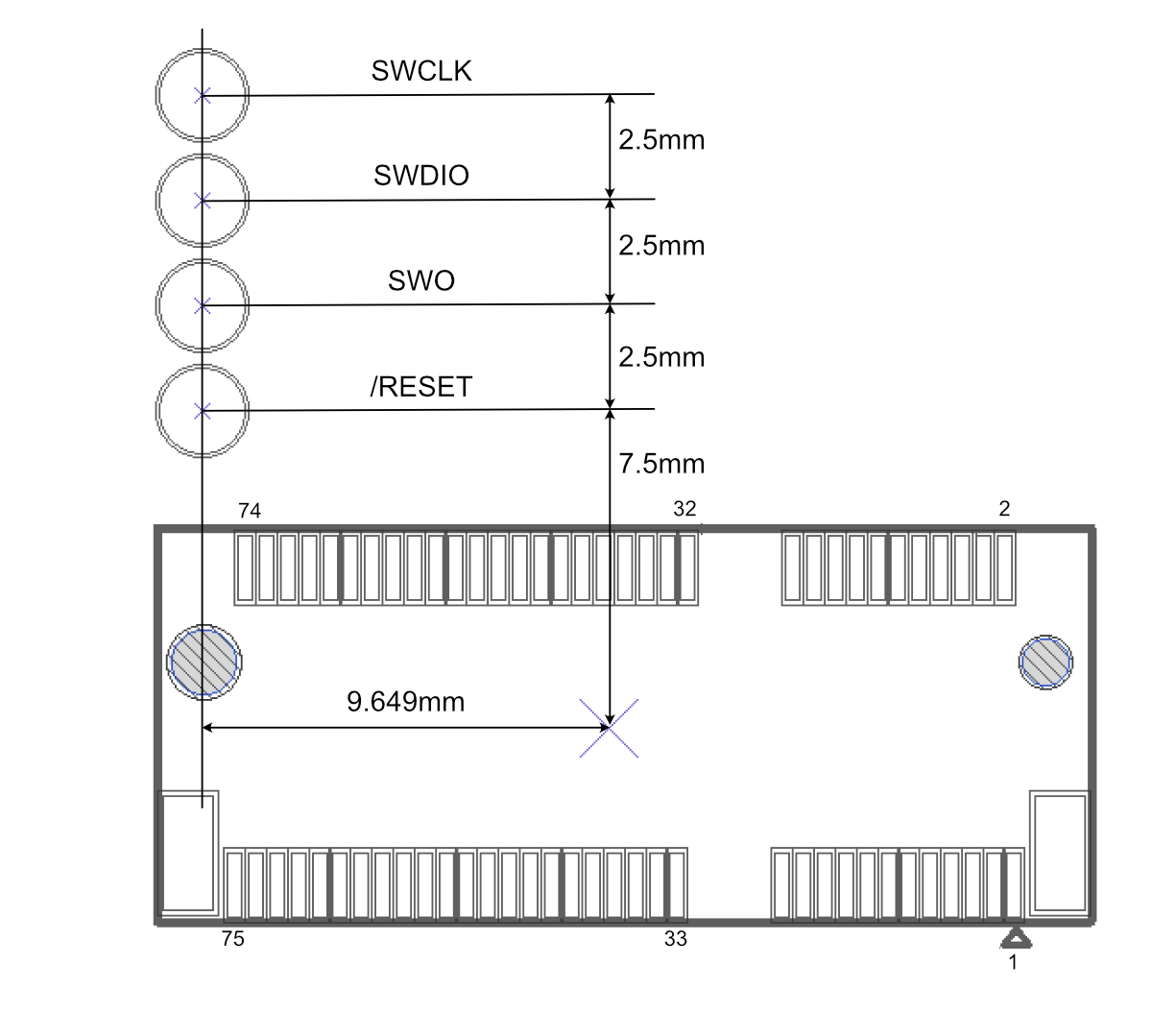
Memory map
nRF52840 flash layout overview
- Bootloader (48KB, @0xF4000)
- User Application
- 256KB @ 0xB4000 (Device OS 3.1 and later)
- 128KB @ 0xD4000 (Device OS 3.0 and earlier)
- System (656KB, @0x30000)
- SoftDevice (192KB)
External SPI flash layout overview (dfu offset: 0x80000000)
- OTA (1500KB, @0x00289000)
- Reserved (420KB, @0x00220000)
- FAC (128KB, @0x00200000)
- LittleFS (2M, @0x00000000)
Pins and button definitions
Pinout diagram

Common SoM pins
RESERVED and SOM pins may vary across different SoM models. If you are designing for this specific module, or similar modules, you can use the indicated functions even if the pin is marked RESERVED. Most nRF52840-based modules will have the same pin functions on the RESERVED pins.
The nRF52840 B-SoM has some differences from the RTL8722 M-SoM. Future modules with a different MCU may have different pin functions. An effort will be made to assign all of the listed functions for ADC, PWM, SPI, etc. from the set of common SoM pin functions in future modules, but the functions on RESERVED and SOM pins will likely vary.
GPIO and port listing
| Pin Name | Module Pin | PWM | MCU | ||||
|---|---|---|---|---|---|---|---|
| A0 / D19 | 23 | ADC1 | ✓ | P0.03 | |||
| A1 / D18 | 33 | ADC2 | ✓ | P0.04 | |||
| A2 / D17 | 35 | ADC4 | P0.28 | ||||
| A3 / D16 | 37 | ADC5 | P0.29 | ||||
| A4 / D15 | 41 | ADC6 | P0.30 | ||||
| A5 / D14 | 43 | ADC7 | P0.31 | ||||
| A6 | 45 | ADC3 | ✓ | P0.05 | |||
| A7 | 47 | ADC0 | ✓ | P0.02 | |||
| CELL USBD- | 46 | ||||||
| CELL USBD+ | 44 | ||||||
| CELL VBUS | 74 | ||||||
| D0 | 22 | Wire (SDA) | P0.26 | ||||
| D1 | 20 | Wire (SCL) | P0.27 | ||||
| D2 | 42 | Wire1 (SDA) | SPI1 (SCK) | Serial1 RTS | P1.02 | ||
| D3 | 40 | Wire1 (SCL) | SPI1 (MOSI) | Serial1 CTS | P1.01 | ||
| D4 | 66 | SPI1 (MISO) | ✓ | P1.08 | |||
| D5 | 68 | ✓ | P1.10 | ||||
| D6 | 70 | ✓ | P1.11 | ||||
| D7 | 72 | ✓ | P1.12 | ||||
| D8 | 48 | SPI (SS) | P1.03 | ||||
| D22 | 62 | P0.24 | |||||
| D23 | 64 | P1.09 | |||||
| MISO / D11 | 50 | SPI (MISO) | P1.14 | ||||
| MOSI / D12 | 52 | SPI (MOSI) | P1.13 | ||||
| NC | 14 | ||||||
| NC | 75 | ||||||
| NFC1 | 17 | P0.09 | |||||
| NFC2 | 19 | P0.10 | |||||
| RGBB | 65 | P0.15 | |||||
| RGBG | 63 | P0.14 | |||||
| RGBR | 61 | P0.13 | |||||
| RX / D10 | 38 | Serial1 RX | P0.08 | ||||
| SCK / D13 | 54 | SPI (SCK) | P1.15 | ||||
| SIM_CLK | 71 | ||||||
| SIM_DATA | 73 | ||||||
| SIM_RST | 69 | ||||||
| SIM_VCC | 67 | ||||||
| TX / D9 | 36 | Serial1 TX | P0.06 | ||||
| USBDATA- | 13 | ||||||
| USBDATA+ | 11 | ||||||
| VUSB | 16 |
ADC (analog to digital converter)
The B404X supports 8 ADC inputs.
| Pin | Pin Name | Description | Interface | MCU |
|---|---|---|---|---|
| 23 | A0 / D19 | A0 Analog in, GPIO, PWM | ADC1 | P0.03 |
| 33 | A1 / D18 | A1 Analog in, GPIO, PWM | ADC2 | P0.04 |
| 35 | A2 / D17 | A2 Analog in, GPIO | ADC4 | P0.28 |
| 37 | A3 / D16 | A3 Analog in, GPIO | ADC5 | P0.29 |
| 41 | A4 / D15 | A4 Analog in, GPIO | ADC6 | P0.30 |
| 43 | A5 / D14 | A5 Analog in, GPIO | ADC7 | P0.31 |
| 45 | A6 | A6 Analog in, PWM, GPIO | ADC3 | P0.05 |
| 47 | A7 | A7 Analog in, GPIO, Ethernet Reset | ADC0 | P0.02 |
- ADC inputs are single-ended and limited to 0 to 3.3V
- Resolution is 12 bits
On the B404X, BRN404X, and E404X, the ADC reference is the nRF52840 internal 0.6V reference, with a 1/6 gain from the input pin. This is different than other Gen 3 devices which use 3V3 as the ADC reference.
This will only affect B404X designs that have a 3V3 voltage that is not 3.3V. Previously, the ADC values would vary with the 3V3 voltage.
This reference and gain combination is a range of 0 to 3.6V for 0 - 4095. This is scaled in software so 3.3V will still be 4095, so there will be a slight loss of resolution.
UART serial
The B404X supports one UART serial interfaces.
| Pin | Pin Name | Description | Interface | MCU |
|---|---|---|---|---|
| 36 | TX / D9 | Serial TX, GPIO | Serial1 TX | P0.06 |
| 38 | RX / D10 | Serial RX, GPIO | Serial1 RX | P0.08 |
| 40 | D3 | SPI1 MOSI, Serial1 CTS, GPIO, Wire1 SCL | Serial1 CTS | P1.01 |
| 42 | D2 | SPI1 SCK, Serial1 RTS, PWM, GPIO, Wire1 SDA | Serial1 RTS | P1.02 |
- The UART pins are 3.3V and must not be connected directly to a RS-232C port or to a 5V TTL serial port
- Hardware flow control is optional; if not used then the RTS and CTS pins can be used as regular GPIO
- You cannot use hardware flow control and Ethernet at the same time.
SPI
The B404X supports two SPI (serial peripheral interconnect) ports.
| Pin | Pin Name | Description | Interface | MCU |
|---|---|---|---|---|
| 40 | D3 | SPI1 MOSI, Serial1 CTS, GPIO, Wire1 SCL | SPI1 (MOSI) | P1.01 |
| 42 | D2 | SPI1 SCK, Serial1 RTS, PWM, GPIO, Wire1 SDA | SPI1 (SCK) | P1.02 |
| 48 | D8 | GPIO, SPI SS, Ethernet CS | SPI (SS) | P1.03 |
| 50 | MISO / D11 | SPI MISO, GPIO | SPI (MISO) | P1.14 |
| 52 | MOSI / D12 | SPI MOSI, GPIO | SPI (MOSI) | P1.13 |
| 54 | SCK / D13 | SPI SCK, GPIO | SPI (SCK) | P1.15 |
| 66 | D4 | SPI1 MISO, PWM, GPIO | SPI1 (MISO) | P1.08 |
- The SPI port is 3.3V and must not be connected directly to devices that drive MISO at 5V
- If not using a SPI port, its pins can be used as GPIO
- Any pins can be used as the SPI chip select
- Multiple devices can generally share a single SPI port
- You cannot use
SPI1and Ethernet at the same time.
I2C
The B404X supports two I2C (two-wire serial interface) ports.
| Pin | Pin Name | Description | Interface | MCU |
|---|---|---|---|---|
| 20 | D1 | I2C SCL, GPIO | Wire (SCL) | P0.27 |
| 22 | D0 | I2C SDA, GPIO | Wire (SDA) | P0.26 |
| 40 | D3 | SPI1 MOSI, Serial1 CTS, GPIO, Wire1 SCL | Wire1 (SCL) | P1.01 |
| 42 | D2 | SPI1 SCK, Serial1 RTS, PWM, GPIO, Wire1 SDA | Wire1 (SDA) | P1.02 |
- The I2C port is 3.3V and must not be connected directly a 5V I2C bus
- Maximum bus speed is 400 kHz
- External pull-up resistors are recommended for I2C as the internal pull-up is 13K.
- If not using I2C, pins D0 and D1 can be used as GPIO or analog input.
- You cannot use
Wire1and Ethernet at the same time.
PWM
The B404X supports PWM (pulse-width modulation) on the following pins:
| Pin | Pin Name | Description | Timer | MCU |
|---|---|---|---|---|
| 23 | A0 / D19 | A0 Analog in, GPIO, PWM | PWM2 | P0.03 |
| 33 | A1 / D18 | A1 Analog in, GPIO, PWM | PWM2 | P0.04 |
| 45 | A6 | A6 Analog in, PWM, GPIO | PWM2 | P0.05 |
| 47 | A7 | A7 Analog in, GPIO, Ethernet Reset | PWM2 | P0.02 |
| 66 | D4 | SPI1 MISO, PWM, GPIO | PWM1 | P1.08 |
| 68 | D5 | PWM, GPIO | PWM1 | P1.10 |
| 70 | D6 | PWM, GPIO | PWM1 | P1.11 |
| 72 | D7 | PWM, GPIO | PWM0 | P1.12 |
- PWM that share the same timer (
PMW2for example) must share the same frequency but can have different duty cycles. - Pin
D7(PWM0) share a timer with the RGB LED and you should not change its frequency but it can have a different duty cycle.
USB
The B404X supports a USB interface for programming the device and for USB serial (CDC) communications. The module itself does not contain a USB connector; you typically add a micro USB or USB C connector on your base board. It is optional but recommended.
| Pin | Pin Name | Description | MCU |
|---|---|---|---|
| 11 | USBDATA+ | USB Data+ | |
| 13 | USBDATA- | USB Data- | |
| 16 | VUSB | USB VUSB power pin | |
| 44 | CELL USBD+ | Cellular Modem USB Data+ | |
| 46 | CELL USBD- | Cellular Modem USB Data- |
- The Cellular Modem USB connector is optional, and can be used for firmware updates of the cellular module.
RGB LED
The B404X supports an external common anode RGB LED.
One common LED that meets the requirements is the Cree CLMVC-FKA-CL1D1L71BB7C3C3 which is inexpensive and easily procured. You need to add three current limiting resistors. With this LED, we typically use 1K ohm current limiting resistors. These are much larger than necessary. They make the LED less blinding but still provide sufficient current to light the LEDs. If you want maximum brightness you should use the calculated values - 33 ohm on red, and 66 ohm on green and blue.
A detailed explanation of different color codes of the RGB system LED can be found here.
The use of the RGB LED is optional, however it is highly recommended as troubleshooting the device without the LED is very difficult.
| Pin | Pin Name | Description | MCU |
|---|---|---|---|
| 61 | RGBR | RGB LED Red | P0.13 |
| 63 | RGBG | RGB LED Green | P0.14 |
| 65 | RGBB | RGB LED Blue | P0.15 |
SETUP and RESET button
It is highly recommended that you add MODE (SETUP) and RESET buttons to your base board using momentary switches that connect to GND. These are necessary to change the operating mode of the device, for example to enter listening or DFU mode.
| Pin | Pin Name | Description | MCU |
|---|---|---|---|
| 32 | MODE / D20 | MODE button, has internal pull-up | P0.11 |
| 34 | RST | Hardware reset, active low. External pull-up required. |
The MODE button does not have a hardware pull-up on it, so you must add an external pull-up (2.2K to 10K) to 3V3, or connect it to 3V3 if not using a button.
The RST pin does have an internal weak pull-up, but you may want to add external pull-up on that as well, especially if you use an off-board reset button connected by long wires.
Pin description
| # | Pin | Common | Function | nRF52 | Description |
|---|---|---|---|---|---|
| 1 | GND | GND | POWER | System ground. | |
| 2 | VCC | VCC | POWER | System power in, connect to the +LiPo or supply a fixed 3.6-4.2v power. | |
| 3 | GND | GND | POWER | System ground. | |
| 4 | VCC | VCC | POWER | System power in, connect to the +LiPo or supply a fixed 3.6-4.2v power. | |
| 5 | GND | GND | POWER | System ground. | |
| 6 | VCC | VCC | POWER | System power in, connect to the +LiPo or supply a fixed 3.6-4.2v power. | |
| 7 | GND | GND | POWER | System ground. | |
| 8 | VCC | VCC | POWER | System power in, connect to the +LiPo or supply a fixed 3.6-4.2v power. | |
| 9 | GND | GND | POWER | System ground. | |
| 10 | 3V3 | 3V3 | POWER | System power in, supply a fixed 3.0-3.6v power. | |
| 11 | USB D+ | USB D+ | IO | Data+ pin of the NRF52840 USB port. | |
| 12 | 3V3 | 3V3 | POWER | System power in, supply a fixed 3.0-3.6v power. | |
| 13 | USB D- | USB D- | IO | Data- pin of the NRF52840 USB port. | |
| 14 | NC | RESERVED3 | NC | Leave unconnected. | |
| 15 | GND | GND | POWER | System ground. | |
| 16 | VUSB | VUSB | POWER | System power in, USB detect pin for nRF52840. 5V on this pin enables the USB interface. | |
| 17 | NFC1 | SOM33 | NFC input | P0.09 | NFC antenna connection. |
| 18 | NC | RESERVED3 | NC | Leave unconnected. | |
| 19 | NFC2 | SOM43 | NFC input | P0.10 | NFC antenna connection. |
| 20 | D1 | SCL | IO | P0.27 | I2C SCL, and digital only GPIO. |
| 21 | GND | GND | POWER | System ground. | |
| 22 | D0 | SDA | IO | P0.26 | I2C SDA, and digital only GPIO. |
| 23 | A0 | ADC0 | IO | P0.03 | Analog input ADC02, and digital GPIO. |
| 32 | MODE | MODE | IO | P0.11 | Connected to the MODE button input, and digital only GPIO. |
| 33 | A1 | ADC1 | IO | P0.04 | Analog input ADC12, and digital GPIO. |
| 34 | RESET | RESET | I | Active-low reset input. | |
| 35 | A2 | ADC2 | IO | P0.28 | Analog input ADC22, and digital GPIO. |
| 36 | D9 | TX | IO | P0.06 | Primarily used as UART TX, but can also be used as a digital GPIO. |
| 37 | A3 | ADC3 | IO | P0.29 | Analog input ADC32, and digital GPIO. |
| 38 | D10 | RX | IO | P0.08 | Primarily used as UART RX, but can also be used as a digital GPIO. |
| 39 | AGND | AGND | POWER | System analog ground. | |
| 40 | D3 | RESERVED3 | IO | P1.01 | UART flow control CTS, SCL1 (Wire1), SPI1 MOSI, digital only GPIO. |
| 41 | A4 | RESERVED3 | IO | P0.30 | Analog input ADC42, and digital GPIO. |
| 42 | D2 | RESERVED3 | IO | P1.02 | UART flow control RTS, SDA1 (Wire1), SPI1 SCK, digital only GPIO. |
| 43 | A5 | RESERVED3 | IO | P0.31 | Analog input ADC52, and digital GPIO. |
| 44 | u-blox USB D+ | SOM0 | IO | Data+ pin of the cellular modem USB port. | |
| 45 | A6 | RESERVED3 | IO | P0.05 | Analog input ADC62, and digital GPIO. |
| 46 | u-blox USB D- | SOM1 | IO | Data- pin of the cellular modem USB port. | |
| 47 | A7 | RESERVED3 | IO | P0.02 | Analog input ADC72, and digital GPIO. |
| 48 | D8 | CS | IO | P1.03 | SPI interface CS, and digital only GPIO. |
| 49 | AGND | AGND | POWER | System analog ground. | |
| 50 | D11 | MISO | IO | P1.14 | SPI interface MISO, and digital only GPIO. |
| 51 | NC | RESERVED3 | NC | Leave unconnected. | |
| 52 | D12 | MOSI | IO | P1.13 | SPI interface MOSI, and digital only GPIO. |
| 53 | NC | RESERVED3 | NC | Leave unconnected. | |
| 54 | D13 | SCK | IO | P1.15 | SPI interface SCK, and digital only GPIO. |
| 55 | NC | RESERVED3 | NC | Leave unconnected. | |
| 56 | GND | GND | POWER | System analog ground. | |
| 57 | NC | RESERVED3 | NC | Leave unconnected. | |
| 58 | NC | RESERVED3 | NC | Leave unconnected. | |
| 59 | NC | RESERVED3 | NC | Leave unconnected. | |
| 60 | NC | RESERVED3 | NC | Leave unconnected. | |
| 61 | RGBR | RED | IO | P0.13 | Red pin of the RGB LED. |
| 62 | D22 | GPIO0 | IO | P0.24 | GPIO0, digital only. |
| 63 | RGBG | GREEN | IO | P0.14 | Green pin of the RGB LED. |
| 64 | D23 | GPIO1 | IO | P1.09 | GPIO1, digital only. |
| 65 | RGBB | BLUE | IO | P0.15 | Blue pin of the RGB LED. |
| 66 | D4 | PWM0 | IO | P1.08 | SPI1 MISO, Digital only GPIO, and PWM0. |
| 67 | SIM_VCC1 | SOM53 | POWER | Leave unconnected, 1.8V/3V SIM Supply Output from cellular modem. | |
| 68 | D5 | PWM1 | IO | P1.10 | Digital only GPIO, and PWM1. |
| 69 | SIM_RST1 | SOM63 | IO | Leave unconnected, 1.8V/3V SIM Reset Output from cellular modem. | |
| 70 | D6 | PWM2 | IO | P1.11 | Digital only GPIO, and PWM2. |
| 71 | SIM_CLK1 | SOM73 | IO | Leave unconnected, 1.8V/3V SIM Clock Output from cellular modem. | |
| 72 | D7 | PWM3 | IO | P1.12 | Digital only GPIO, and PWM3. |
| 73 | SIM_DATA1 | SOM83 | IO | Leave unconnected, 1.8V/3V SIM Data I/O of cellular modem with internal 4.7 k pull-up. | |
| 74 | u-blox VBUS | SOM23 | IO | USB detect pin for cellular modem. 5V on this pin enables the u-blox USB interface. | |
| 75 | NC | SOM93 | NC | Leave unconnected. |
1These pins are connected to the internal MFF2 SIM and should be left open.
2A0-A7 are 12-bit Analog-to-Digital (A/D) inputs (0-4095).
3SoM-specific and Reserved pins will vary depending on module. They are able to be used on the B402, but their function may be be different on future modules.
By default, the Tinker application firmware enables the use of the bq24195 PMIC and MAX17043 fuel gauge. This in turn uses I2C (D0 and D1) and pin A6 (PM_INT). If you are not using the PMIC and fuel gauge and with to use these pins for other purposes, be sure to disable system power configuration. This setting is persistent, so you may want to disable it with your manufacturing firmware only.
System.setPowerConfiguration(SystemPowerConfiguration());
If you are using Ethernet with the B-Series SoM, the following pins are used by Ethernet:
| Device OS Pin | M.2 Pin | Ethernet Pin |
|---|---|---|
| MISO | 50 | SPI MISO |
| MOSI | 52 | SPI MOSI |
| SCK | 54 | SPI SCK |
| A7 | 47 | nRESET |
| D22 | 62 | nINTERRUPT |
| D8 | 48 | nCHIP SELECT |
Cellular modem USB pins
The cellular modem USB pins are optional on custom base boards. These pins are used for low-level diagnostics and reprogramming the cellular modem firmware.
Note, however, the Particle has never done a cellular modem firmware upgrade in the field because doing so generally requires recertification, and is there is a high likelihood that the upgrade will fail, rendering the modem unusable.
Cellular modem could be reprogrammed by removing the SoM from your board and putting it in the M.2 SoM breakout board, which has the cellular modem USB connector.
| # | Pin | Common | Function | nRF52 | Description |
|---|---|---|---|---|---|
| 44 | u-blox USB D+ | SOM0 | IO | Data+ pin of the cellular modem USB port. | |
| 46 | u-blox USB D- | SOM1 | IO | Data- pin of the cellular modem USB port. | |
| 74 | u-blox VBUS | SOM23 | IO | USB detect pin for cellular modem. 5V on this pin enables the u-blox USB interface. |
Complete module pin details

LED status
System RGB LED
Unlike the Boron, the B402 module does not have an on-module RGB system status LED. We have provided its individual control pins for you to connect an LED of your liking. This will allow greater flexibility in the end design of your products.
A detailed explanation of different color codes of the RGB system LED can be found here.
PMIC Notes
When using the B-Series SoM with a bq24195 PMIC, note the following:
By default, the bq24195 sets the input current limit, which affects powering by VIN and VUSB, to 100 mA. This affects the VSYS output of the PMIC, which powers both the cellular modem and 3V3 supply, and is not enough to power the B-Series SoM in normal operation.
If your device has the default firmware (Tinker), it will attempt to connect to the cloud, brown out due to insufficient current, then the device will reset. This may result in what appears to be the status LED blinking white, but is actually rolling reboot caused by brownout.
A factory new B-Series SoM does not enable the PMIC setup. To enable the use of the bq21415, you must enable the system power feature PMIC_DETECTION in your code. This defaults to off because the B-Series SoM can be used without a PMIC, or with a different PMIC, and also requires I2C on D0/D1, and some base boards may use those pins as GPIO.
Because the input current limit does not affect the battery input (Li+), for troubleshooting purposes it can be helpful to attach a battery to help rule out input current limit issues. It's also possible to supply 3.7V via a bench power supply to the battery input, instead of VIN.
The input current limit can result in a situation where you can't bring up a B-Series SoM because it browns out continuously, but also cannot flash code to it to stop if from browning out. There are two general solutions:
- Attach a battery or supply by Li+ when bringing up a board.
- Use SWD/JTAG and reset halt the MCU. This will prevent it from connecting to the cloud, so you can flash Device OS and firmware to it by SWD.
The input current limit is actually controlled by three factors:
- The power source max current setting in the PMIC. The default is 900 mA. It can be set to 100, 150, 500, 900, 1200, 1500, 2000, or 3000 mA.
- It is also limited by the hardware ILIM resistor. On Particle devices with a built-in PMIC, this is set to 1590 mA, but if you are implementing your own PMIC hardware, you can adjust this higher.
- When connected by USB, it will use DPDM, current negotiation via the USB DP (D+) and DM (D-) lines.
Note that some 2A tablet chargers and multi-port USB power supplies supply 2A but do not implement DPDM; these will be treated as if VIN was used, and you must set the power source current, otherwise the input current will be limited to 900 mA, which is not enough to power a 2G/3G cellular modem without an attached battery.
Technical specifications
Absolute maximum ratings [1]
Supply voltages
| Parameter | Symbol | Min | Typ | Max | Unit |
|---|---|---|---|---|---|
| Supply voltages | |||||
| Supply Input Voltage | VCC | -0.3 | +6.0 | V | |
| Supply Input Voltage | 3V3 | -0.3 | +3.9 | V | |
| VBUS USB supply voltage | VUSB | -0.3 | +5.8 | V | |
| I/O pin voltage | |||||
| VI/O, VDD ≤ 3.6 V | IO | -0.3 | VDD + 0.3 | V | |
| VI/O, VDD > 3.6 V | IO | -0.3 | +3.9 | V | |
| NFC antenna pin current | |||||
| INFC1/2 | NFC1/NFC2 | 80 | mA | ||
| Radio | |||||
| BT RF input level (52840) | 10 | dBm | |||
| Environmental | |||||
| Storage temperature | -40 | +85 | °C |
[1] Stresses beyond those listed under absolute maximum ratings may cause permanent damage to the device. These are stress ratings only, and functional operation of the device at these or any other conditions beyond those indicated under recommended operating conditions is not implied. Exposure to absolute-maximum-rated conditions for extended periods may affect device reliability.
Recommended operating conditions
| Parameter | Symbol | Min | Typ | Max | Unit |
|---|---|---|---|---|---|
| Supply voltages | |||||
| Supply Input Voltage | VCC | +3.6 | +3.8 | +4.2 | V |
| Supply Input Voltage | 3V3 | +3.0 | +3.3 | +3.6 | V |
| VBUS USB supply voltage | VUSB | +4.35 | +5.0 | +5.5 | V |
| Environmental | |||||
| Normal operating temperature1 | -20 | +25 | +65 | °C | |
| Extended operating temperature2 | -40 | +85 | °C | ||
| Humidity Range Non condensing, relative humidity | 95 | % |
Notes:
1 Normal operating temperature range (fully functional and meet 3GPP specifications).
2 Extended operating temperature range (RF performance may be affected outside normal operating range, though module is fully functional)
Power consumption
Values are from B404/B402. Actual operating current with cellular using the R510 modem may vary but should be similar.
| Parameter | Symbol | Min | Typ | Peak | Unit |
|---|---|---|---|---|---|
| Operating Current (uC on, peripherals and radio disabled) | Iidle | 4.48 | 4.71 | 5.17 | mA |
| Operating Current (uC on, cellular on but not connected) | Icell_idle | 5.1 | 45.2 | 166 | mA |
| Operating Current (uC on, cellular connecting to tower) | Icell_conn_twr | 13.7 | 56.0 | 192 | mA |
| Operating Current (uC on, cellular connecting to cloud) | Icell_conn_cloud | 63.2 | 185 | mA | |
| Operating Current (uC on, cellular connected but idle) | Icell_cloud_idle | 13.4 | 15.5 | 98.3 | mA |
| Operating Current (uC on, cellular connected and transmitting) | Icell_cloud_tx | 9.47 | 66.3 | 192 | mA |
| STOP mode sleep, GPIO wake-up | Istop_gpio | 552 | 555 | 559 | uA |
| STOP mode sleep, analog wake-up | Istop_analog | 554 | 557 | 559 | uA |
| STOP mode sleep, RTC wake-up | Istop_intrtc | 553 | 556 | 558 | uA |
| STOP mode sleep, BLE wake-up, advertising | Istop_ble_adv | 631 | 2650 | uA | |
| STOP mode sleep, BLE wake-up, connected | Istop_ble_conn | 47.3 | 630 | 1540 | uA |
| STOP mode sleep, serial wake-up | Istop_usart | 553 | 556 | 558 | uA |
| STOP mode sleep, cellular wake-up | Istop_cell | 8.87 | 9.65 | 63.6 | mA |
| ULP mode sleep, GPIO wake-up | Iulp_gpio | 44.7 | 47.6 | 49.6 | uA |
| ULP mode sleep, analog wake-up | Iulp_analog | 45.0 | 47.8 | 49.5 | uA |
| ULP mode sleep, RTC wake-up | Iulp_intrtc | 43.4 | 46.4 | 47.9 | uA |
| ULP mode sleep, BLE wake-up, advertising | Iulp_ble_adv | 130 | 2560 | uA | |
| ULP mode sleep, BLE wake-up, connected | Iulp_ble_conn | 121 | 1010 | uA | |
| ULP mode sleep, serial wake-up | Iulp_usart | 554 | 557 | 559 | uA |
| ULP mode sleep, cellular wake-up | Iulp_cell | 0.37 | 9.47 | 53.7 | mA |
| HIBERNATE mode sleep, GPIO wake-up | Ihib_gpio | 23.6 | 26.0 | 29.7 | uA |
| HIBERNATE mode sleep, analog wake-up | Ihib_analog | 23.9 | 26.5 | 30.5 | uA |
1The min, and particularly peak, values may consist of very short transients. The typical (typ) values are the best indicator of overall power consumption over time. The peak values indicate the absolute minimum capacity of the power supply necessary, not overall consumption.
Radio specifications
The B-Series SoM has two radio modules.
Nordic Semiconductor nRF52840 for BLE
| Feature | Description |
|---|---|
| Feature | Bluetooth LE 5 |
| Operating Frequencies | 2400 to 2480 MHz |
| Output Power | Programmable -20dBm to +8dBm |
| PLL channel spacing | 1 MHz |
| On the air data rate | 125 to 2000 kbps |
Nordic Semiconductor nRF52840 for NFC tag
| Feature | Description |
|---|---|
| Feature | NFC Tag-A |
| Frequency | 13.56 MHz |
u-blox SARA-R510S-01B
| Parameter | Value | FCC Certified |
|---|---|---|
| Protocol stack | 3GPP Release 13 LTE Cat M1 | |
| 3GPP Release 14 LTE Cat M11 | ||
| RAT | LTE Cat M1 Half-Duplex | |
| LTE FDD Bands | Band 71 (600 MHz) | |
| Band 12 (700 MHz) | ✓ | |
| Band 28 (700 MHz) | ||
| Band 85 (700 MHz) | ||
| Band 13 (750 MHz) | ✓ | |
| Band 20 (800 MHz) | ||
| Band 5 (850 MHz) | ✓ | |
| Band 18 (850 MHz) | ||
| Band 19 (850 MHz) | ||
| Band 26 (850 MHz) | ||
| Band 8 (900 MHz) | ||
| Band 4 (1700 MHz) | ||
| Band 3 (1800 MHz) | ||
| Band 2 (1900 MHz) | ✓ | |
| Band 25 (1900 MHz) | ||
| Band 1 (2100 MHz) | ||
| Power class | Class 3 (23 dBm) | |
| Cellular data rate | up to 1200 kbit/s UL | |
| up to 375 kbit/s DL |
- LTE Cat M1 for United States, Canada, and Mexico.
- FCC Certification in the United States only tests bands in use in the United States.
- Bands not listed as certified are disabled in the Device OS operating system and cannot be enabled from user firmware.
- Particle LTE Cat M1 devices are not certified for use in Europe or other countries that follow EU certification requirements.
- 13GPP Release 14 LTE Cat M1: Coverage Enhancement Mode B, Uplink TBS of 2984b
I/O characteristics
These specifications are based on the nRF52840 datasheet.
| Symbol | Parameter | Min | Typ | Max | Unit |
|---|---|---|---|---|---|
| VIH | Input high voltage | 0.7 xVDD | VDD | V | |
| VIL | Input low voltage | VSS | 0.3 xVDD | V | |
| VOH,SD | Output high voltage, standard drive, 0.5 mA, VDD ≥1.7 | VDD - 0.4 | VDD | V | |
| VOH,HDH | Output high voltage, high drive, 5 mA, VDD >= 2.7 V | VDD - 0.4 | VDD | V | |
| VOH,HDL | Output high voltage, high drive, 3 mA, VDD >= 1.7 V | VDD - 0.4 | VDD | V | |
| VOL,SD | Output low voltage, standard drive, 0.5 mA, VDD ≥1.7 | VSS | VSS + 0.4 | V | |
| VOL,HDH | Output low voltage, high drive, 5 mA, VDD >= 2.7 V | VSS | VSS + 0.4 | V | |
| VOL,HDL | Output low voltage, high drive,3 mA, VDD >= 1.7 V | VSS | VSS + 0.4 | V | |
| IOL,SD | Current at VSS+0.4 V, output set low, standard drive, VDD≥1.7 | 1 | 2 | 4 | mA |
| IOL,HDH | Current at VSS+0.4 V, output set low, high drive, VDD >= 2.7V | 6 | 10 | 15 | mA |
| IOL,HDL | Current at VSS+0.4 V, output set low, high drive, VDD >= 1.7V | 3 | mA | ||
| IOH,SD | Current at VDD-0.4 V, output set high, standard drive, VDD≥1.7 | 1 | 2 | 4 | mA |
| IOH,HDH | Current at VDD-0.4 V, output set high, high drive, VDD >= 2.7V | 6 | 9 | 14 | mA |
| IOH,HDL | Current at VDD-0.4 V, output set high, high drive, VDD >= 1.7V | 3 | mA | ||
| tRF,15pF | Rise/fall time, standard drivemode, 10-90%, 15 pF load1 | 9 | ns | ||
| tRF,25pF | Rise/fall time, standard drive mode, 10-90%, 25 pF load1 | 13 | ns | ||
| tRF,50pF | Rise/fall time, standard drive mode, 10-90%, 50 pF load1 | 25 | ns | ||
| tHRF,15pF | Rise/Fall time, high drive mode, 10-90%, 15 pF load1 | 4 | ns | ||
| tHRF,25pF | Rise/Fall time, high drive mode, 10-90%, 25 pF load1 | 5 | ns | ||
| tHRF,50pF | Rise/Fall time, high drive mode, 10-90%, 50 pF load1 | 8 | ns | ||
| RPU | Pull-up resistance | 11 | 13 | 16 | kΩ |
| RPD | Pull-down resistance | 11 | 13 | 16 | kΩ |
| CPAD | Pad capacitance | 3 | pF | ||
| CPAD_NFC | Pad capacitance on NFC pads | 4 | pF | ||
| INFC_LEAK | Leakage current between NFC pads when driven to different states | 1 | 10 | μA |
Rise and fall times based on simulations
GPIO default to standard drive (2mA) but can be reconfigured to high drive (9mA) in Device OS 2.0.0 and later using the
pinSetDriveStrength()function.
Mechanical specifications
Dimensions and weight
| Parameters | Value | Unit |
|---|---|---|
| Width | 30 | mm |
| Height | 42 | mm |
| Thickness | 5.5 | mm |
| Weight | 6.2 | grams |
3D models
3D models of the B-Series SoM module are available in the hardware-libraries Github in formats including step, iges, stl, and f3d.
The 3D models are the same for the B404X and B402 as the cellular modem module is the same size.
Mechanical drawing
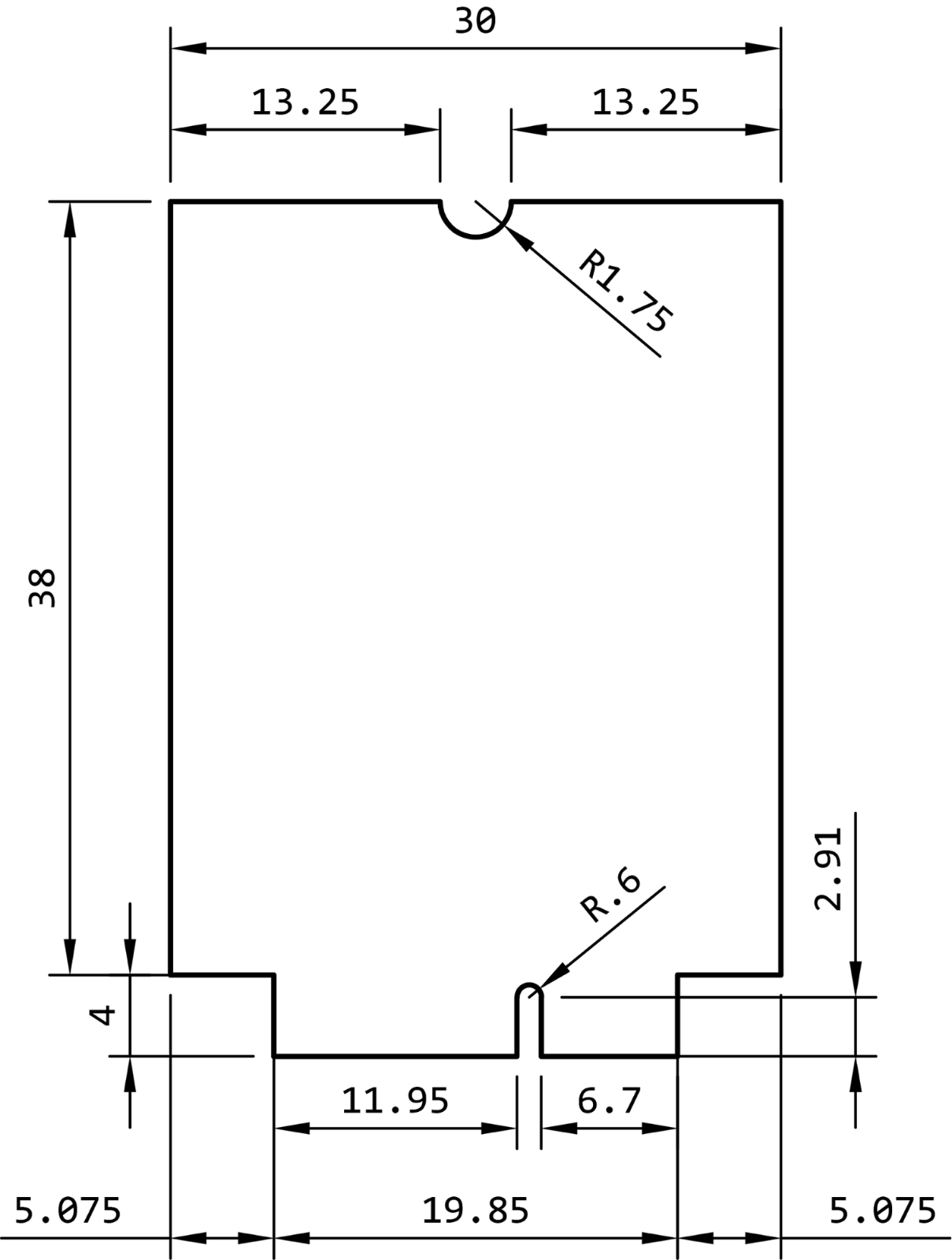
Dimensions are in millimeters.
Mating connector and land pattern
The mating connector is a an M.2 (NGFF) type 4. Note that there are several different key configurations for the M.2, and type 4 is different than is commonly used on SSDs.
One compatible connector is the TE 2199230-4. It is widely available including at suppliers such as DigiKey.
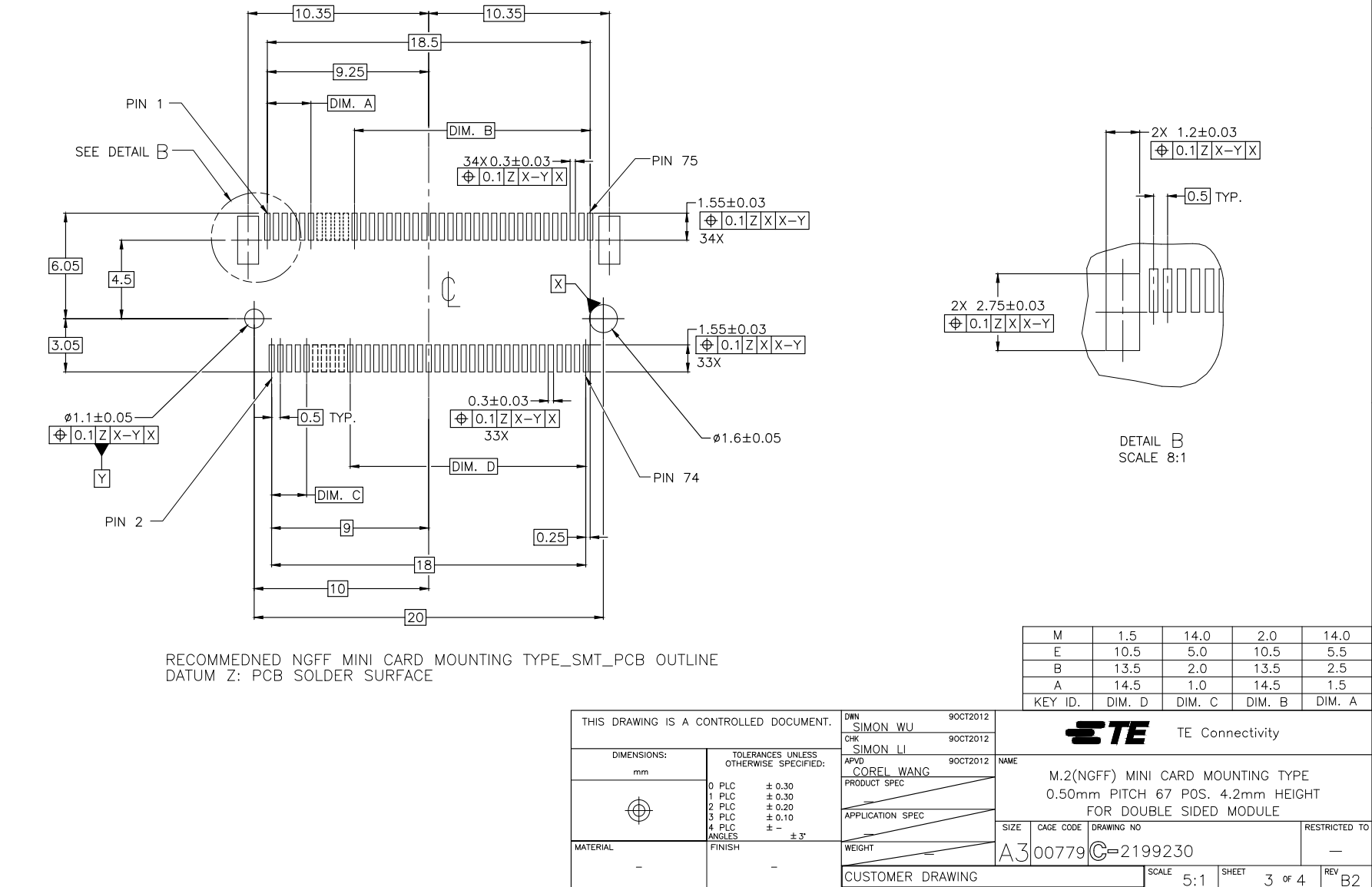
Screw assembly
The M.2 SoM requires a screw to hold the SoM in place because the M.2 connector does not have integrated locks and the SoM will pop up if not attached to the base board. The screw also provides better vibration resistance than locking clips.
- This is one style of standoff.
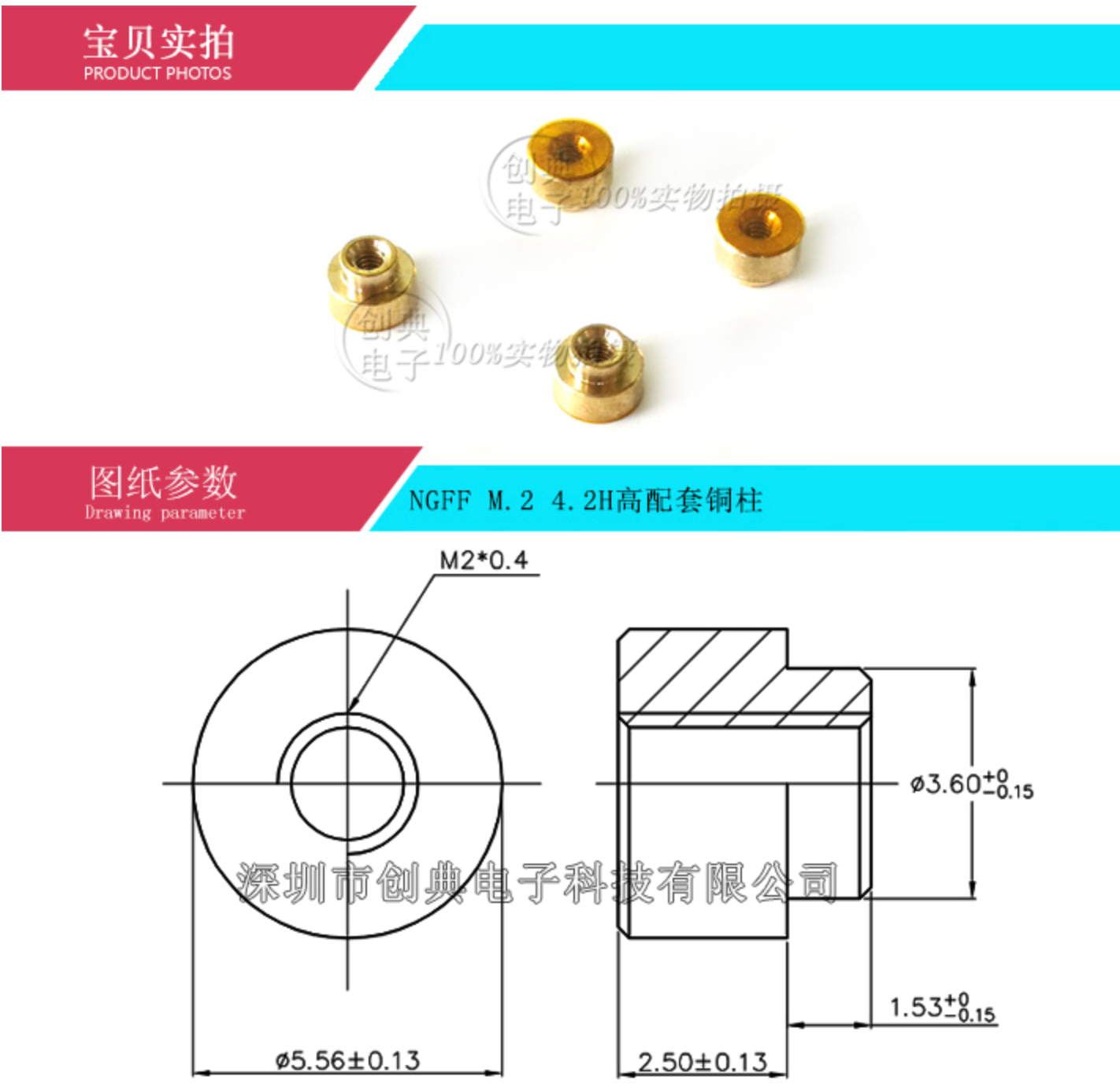
- An alternative design uses a JAE SM3ZS067U410-NUT1-R1200 standoff. It's reflow soldered to your base board and has a threaded hole for a M2*3 screw to hold down the SoM. This may be easier to obtain.
- The screw should be connected to the ground plane on your base board.
Design considerations
We strongly recommend against placing components under the SOM board because there is not enough height.
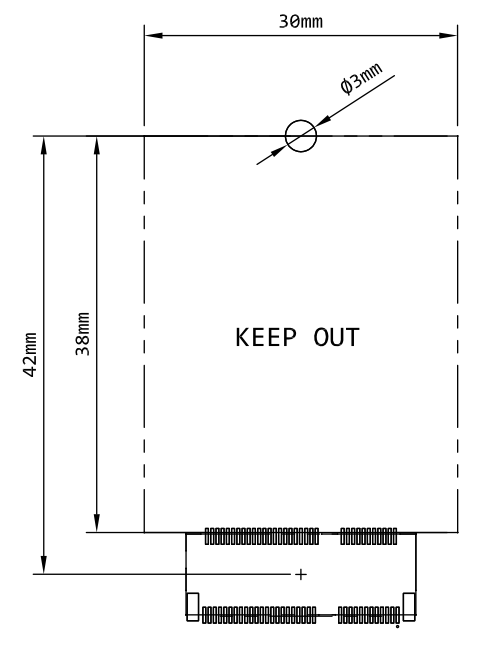
Product handling
ESD precautions
The B series contains highly sensitive electronic circuitry and is an Electrostatic Sensitive Device (ESD). Handling an B series without proper ESD protection may destroy or damage it permanently. Proper ESD handling and packaging procedures must be applied throughout the processing, handling and operation of any application that incorporates the B series module. ESD precautions should be implemented on the application board where the B series is mounted. Failure to observe these precautions can result in severe damage to the B series!
Connectors
The U.FL antenna connector is not designed to be constantly plugged and unplugged. The antenna pin is static sensitive and you can destroy the radio with improper handling. A tiny dab of glue (epoxy, rubber cement, liquid tape or hot glue) on the connector can be used securely hold the plug in place.
The M.2 edge connector is static sensitive and should be handled carefully. The M.2 connector is not designed for repeated removal and insertion of the module.
Schematics
Microcontroller
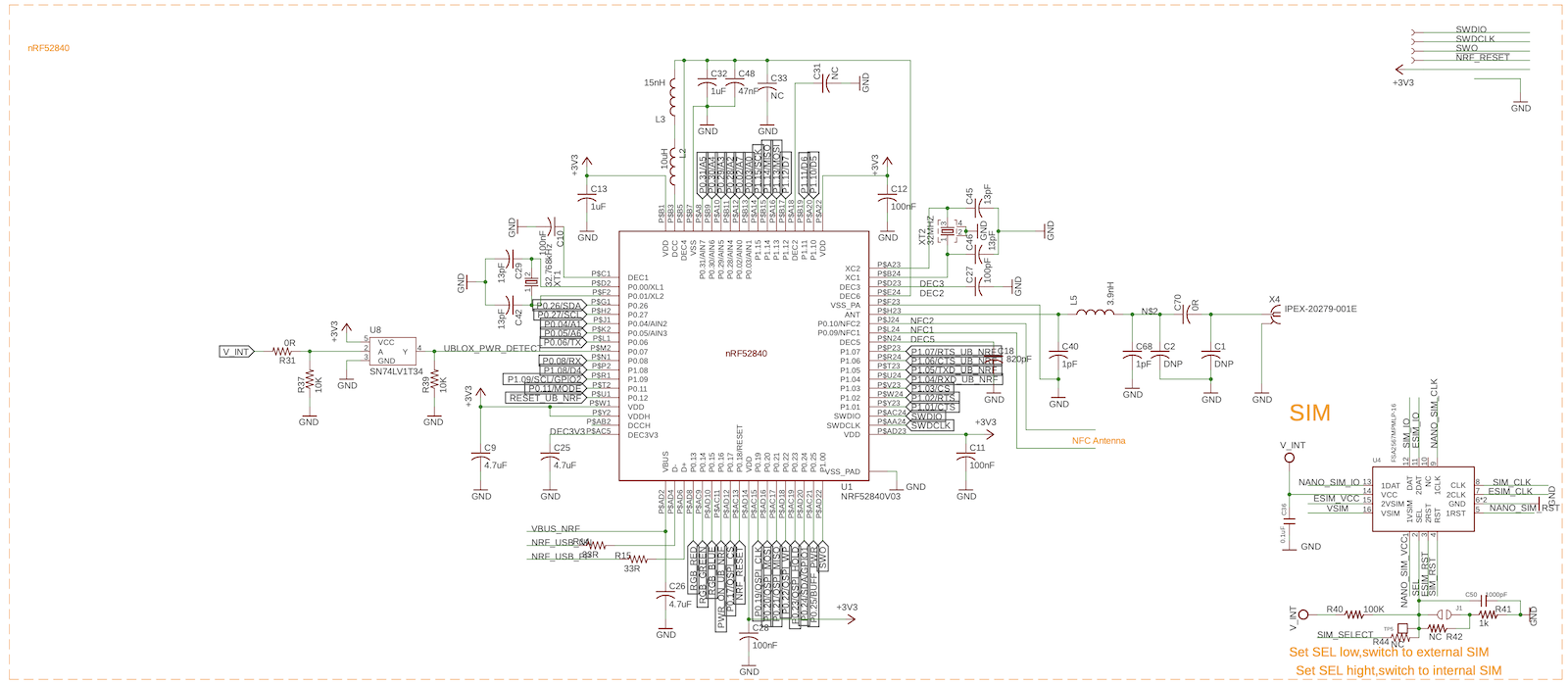
u-blox cellular modem
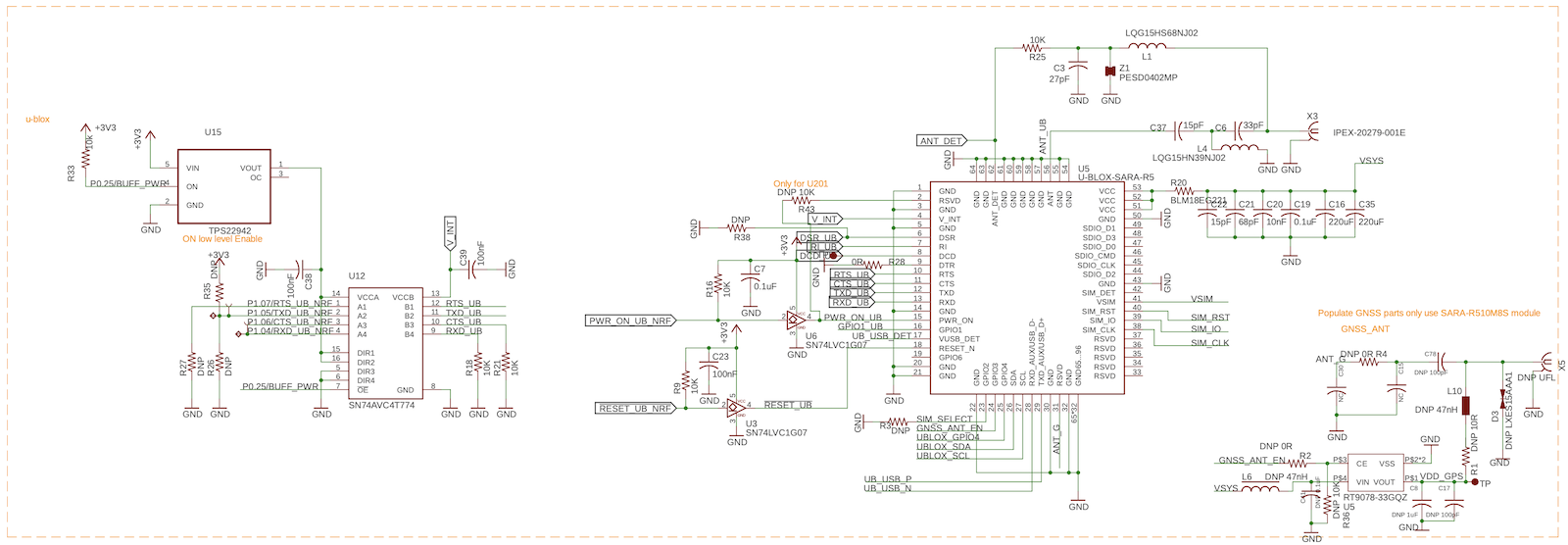
M.2 connector
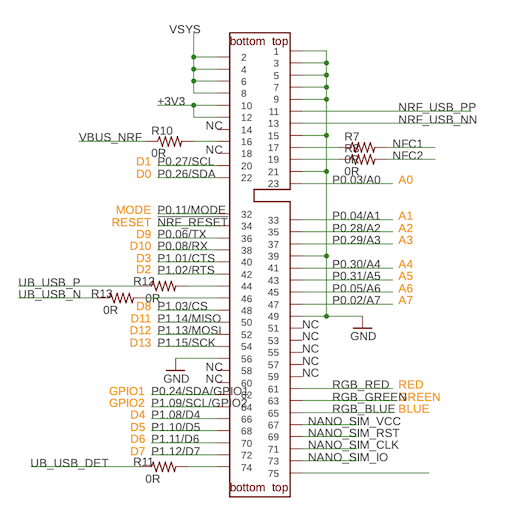
Note: An earlier version of this document had reversed the labels D2 and D3 in the diagram located here. The correct assignments are pictured above and are as follows:
| SoM Pin | nRF52 Pin | Device OS Pin | Serial1 Flow Control |
|---|---|---|---|
| 40 | P1.01 | D3 | CTS |
| 42 | P1.02 | D2 | RTS |
SIM and Flash
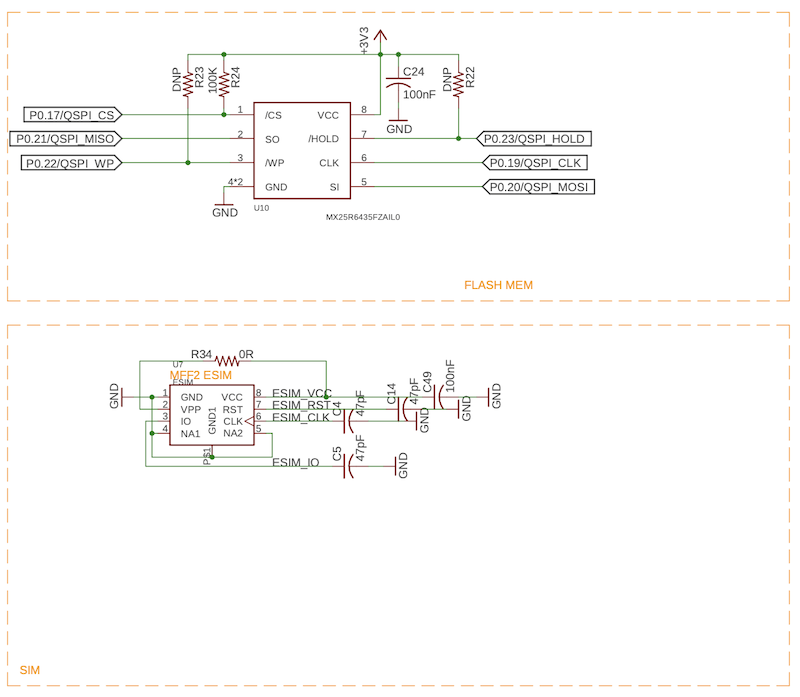
Assembly
Conformal coatings
B-Series SoM modules should not use a conformal coating to protect the module from water. Some components on the SoM cannot be coated and would need to be masked off during coating. This will make the coating process difficult to implement and test.
Furthermore, you cannot safely protect the the connection between the M.2 SoM and the M.2 NGFF connector by using a coating. Using an enclosure that protects both your base board and the B-Series SoM as a single waterproof assembly is recommended instead.
Default settings
The B series comes pre-programmed with a bootloader and a user application called Tinker. This application works with an iOS and Android app also named Tinker that allows you to very easily toggle digital pins, take analog and digital readings and drive variable PWM outputs.
The bootloader allows you to easily update the user application via several different methods, USB, OTA, Serial Y-Modem, and also internally via the Factory Reset procedure. All of these methods have multiple tools associated with them as well.
FCC ISED CE warnings and end product labeling requirements
Federal Communication Commission Interference Statement This equipment has been tested and found to comply with the limits for a Class B digital device, pursuant to Part 15 of the FCC Rules. These limits are designed to provide reasonable protection against harmful interference in a residential installation. This equipment generates, uses and can radiate radio frequency energy and, if not installed and used in accordance with the instructions, may cause harmful interference to radio communications. However, there is no guarantee that interference will not occur in a particular installation. If this equipment does cause harmful interference to radio or television reception, which can be determined by turning the equipment off and on, the user is encouraged to try to correct the interference by one of the following measures:
- Reorient or relocate the receiving antenna.
- Increase the separation between the equipment and receiver.
- Connect the equipment into an outlet on a circuit different from that to which the receiver is connected.
- Consult the dealer or an experienced radio/TV technician for help.
FCC Caution: Any changes or modifications not expressly approved by the party responsible for compliance could void the user's authority to operate this equipment. This device complies with Part 15 of the FCC Rules. Operation is subject to the following two conditions:
- This device may not cause harmful interference, and
- This device must accept any interference received, including interference that may cause undesired operation.
FCC Radiation Exposure Statement: This equipment complies with FCC radiation exposure limits set forth for an uncontrolled environment. This transmitter module must not be co-located or operating in conjunction with any other antenna or transmitter. This End equipment should be installed and operated with a minimum distance of 20 centimeters between the radiator and your body.
IMPORTANT NOTE: In the event that these conditions can not be met (for example certain laptop configurations or co-location with another transmitter), then the FCC authorization is no longer considered valid and the FCC ID can not be used on the final product. In these circumstances, the OEM integrator will be responsible for re-evaluating the end product (including the transmitter) and obtaining a separate FCC authorization.
End Product Labeling The final end product must be labeled in a visible area with the following:
- Contains FCC ID: 2AEMI-B404X
Manual Information to the End User The OEM integrator has to be aware not to provide information to the end user regarding how to install or remove this RF module in the user’s manual of the end product which integrates this module.
Canada Statement This device complies with Industry Canada’s licence-exempt RSSs. Operation is subject to the following two conditions:
- This device may not cause interference; and
- This device must accept any interference, including interference that may cause undesired operation of the device.
Le présent appareil est conforme aux CNR d’Industrie Canada applicables aux appareils radio exempts de licence.
L’exploitation est autorisée aux deux conditions suivantes:
- l’appareil ne doit pas produire de brouillage;
- l’utilisateur de l’appareil doit accepter tout brouillage radioélectrique subi, même si le brouillage est susceptible d’en compromettre le fonctionnement.
Caution Exposure: This device meets the exemption from the routine evaluation limits in section 2.5 of RSS102 and users can obtain Canadian information on RF exposure and compliance. Le dispositif répond à l'exemption des limites d'évaluation de routine dans la section 2.5 de RSS102 et les utilisateurs peuvent obtenir des renseignements canadiens sur l'exposition aux RF et le respect.
The final end product must be labelled in a visible area with the following: The Industry Canada certification label of a module shall be clearly visible at all times when installed in the host device, otherwise the host device must be labelled to display the Industry Canada certification number of the module, preceded by the words “Contains transmitter module”, or the word “Contains”, or similar wording expressing the same meaning, as follows:
- Contains transmitter module ISED: 20127-B404X
This End equipment should be installed and operated with a minimum distance of 20 centimeters between the radiator and your body. Cet équipement devrait être installé et actionné avec une distance minimum de 20 centimètres entre le radiateur et votre corps.
The end user manual shall include all required regulatory information/warning as shown in this manual.
Certification documents
Bluetooth - B404X B-Series SoM
CE (Europe) - B404X B-Series SoM
The B404X are not certified for use in Europe at this time. The B524 (LTE Cat M1 with 2G/3G fallback) is recommended instead.
FCC (United States) - B404X B-Series SoM
- FCC ID: 2AEMI-B404X
- Grant of equipment authorization (DTS)
- Grant of equipment authorization (PCB)
- Attestation 15 Subpart B, Class B (sDoC)
- RF Exposure Report FCC Part 2, Section 2.1091
- Test report FCC Part 15 Subpart C, Section 15.247
- Test report FCC Part 22, Part 24, Part 27
ISED (Canada) - B404X B-Series SoM
- ISED: 20127-B404X
- Certificate of Conformity
- Test Report RSS-247 Issue 2, RSS-Gen Issue 5
- Test Report ICES-003 Issue 7:2020 Class B
- Test Report RS-132 Issue 3, RSS-133 Issue 6, RSS-139 Issue 4
Country compatibility
| Country | Technologies | Carriers |
|---|---|---|
| Canada | M1 | Bell Mobility, Rogers Wireless, Telus |
| Mexico | M1 | AT&T, Telcel |
| United States | M1 | AT&T, T-Mobile (USA), Verizon7 |
Ordering information
| SKU | Description | Region | Modem | EtherSIM | Lifecycle | Replacement |
|---|---|---|---|---|---|---|
| B404XMEA | B-Series LTE-M (NorAm, EtherSIM), [x1] | NORAM | R510 | ✓ | GA | |
| B404XMTY | B-Series LTE-M (NorAm, EtherSIM), Tray [x50] | NORAM | R510 | ✓ | GA |
Revision history
| Revision | Date | Author | Comments |
|---|---|---|---|
| 018 | 2022-08-29 | RK | Split out from B404 and B402 |
| 019 | 2022-09-06 | RK | Update certified cellular antenna |
| 020 | 2022-09-07 | RK | Add additional port and pin information |
| 021 | 2022-09-16 | RK | Added FCC and ISED |
| 022 | 2022-09-16 | RK | Fix minimum Device OS version, is 4.0.0 |
| 023 | 2022-09-26 | RK | Added FCC and ISED labeling requirements |
| 024 | 2022-12-10 | RK | Added PMIC notes |
| 025 | 2022-12-13 | RK | Update block diagram and antenna information |
| 026 | 2023-01-06 | RK | Clarify power supply notes for VCC and 3V3, ADC |
| 027 | 2023-01-11 | RK | Updated certifications, added ISED, removed PTCRB |
| 028 | 2023-01-17 | RK | Added FCC § 2.1033(b)(5) Block Diagram |
| 029 | 2023-01-31 | RK | Add Device OS versions |
| 030 | 2023-03-07 | RK | Update BLE antenna text |
| 031 | 2023-04-28 | RK | Add conformal coating warning |
| 033 | 2023-06-07 | RK | Fixed diagram of M.2 connector in schematics |
| 034 | 2023-07-18 | RK | Added alternate antenna ANT-FLXU |
| 035 | 2023-11-13 | RK | Add full pin details |
| 036 | 2024-02-20 | RK | M.2 screw assembly should be connected to ground |
| 037 | 2024-04-23 | RK | Added links to certification documents |
| 038 | 2024-09-03 | RK | Added clarification of cellular modem USB pins |
| 039 | 2025-09-03 | RK | Corrected the BLE operating frequency to 2400 to 2480 MHz |

